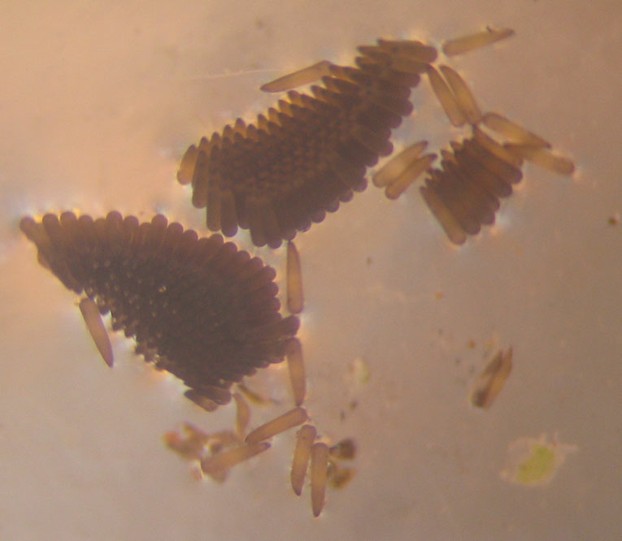Partly broken egg raft of a Culex species shows individual egg shapes in newly created (two weeks) pond west of Munch, near city border, southeastern Germany.
image obtained June 7, 2007, 14:14, via binocular's okular with digital camera: Steffen Dietzel, Public Domain, via Wikimedia Commons @ https://commons.wikimedia.org/wiki/File:Gelege1.jpg
Staphylococcus epidermidis colonies: Hardy microorganism numbers among normal human microflora, especially skin, and attracts mosquitoes.
Staphylococcus epidermidis on Tryptic Soy Agar; cultivation 24 hours, 37°C. (98.6°F.)
HansN., CC BY SA 3.0, via Wikimedia Commons @ https://commons.wikimedia.org/wiki/File:Staphylococcus_epidermidis_colonies_on_Tryptic_Soy_Agar.jpg
Sweet wormwood (Artemisia annua): Extracts such as leaf juice serve as natural mosquito repellents.
Mosquitoes shy away from sweet wormwood; break off a leaf from the plant and rub on skin for immediate effectiveness.
Beaver, Raleigh County, soutthern West Virginia: Jorge Ferreira, Public Domain, via Wikimedia Commons @ https://commons.wikimedia.org/wiki/File:Artemisia_annua_West_Virginia.jpg
Native to northeastern Queensland in the Land Down Under, lemon eucalyptus trees (Corymbia citriodora), also known as lemon-scented gum, waft an aroma repugnant to mosquitoes.
An extract from the tree's leaves and twigs serves as an effective repellent and a natural alternative to chemical products such as DEET.
Botanic Garden Zoo (also called Wagga Zoo) at Wagga Wagga Botanic Gardens, southeastern New South Wales, southeast Australia: Bidgee, CC BY 3.0, via Wikimedia Commons @ https://commons.wikimedia.org/wiki/File:Corymbia_citriodora.jpg
Anopheles stephensi (Asian malaria mosquito; Indo-Pakistan malaria mosquito) is a known malarial vector with a distribution range from Egypt to China.
Engorged female Anopheles stephensi expels blood from abdomen while obtaining human host blood meal via pointed proboscis.: Jim Gathany, CDC Public Health Image Library (PHIL) @ https://phil.cdc.gov/details.aspx?pid=5814
DEET (N,N-diethyl-meta-toluamide), developed by U.S. Army in 1946, is an effective chemical repellent that blocks insects' olfactory receptors and also exudes an odor that mosquitoes dislike.
Health issues such as insomnia, mood swings, seizures, and skin irritations may be experienced via products with concentrations of DEET well in excess of 30 percent.
DEET-based products include Cutter Skinsations, DEET Plus, Off! and Ultrathon; Image no. K7243-10: Photo by Scott Bauer, Public Domain, via USDA Agricultural Research Service (ARS) @ https://www.ars.usda.gov/oc/images/photos/k7243-10/













 Are Hawaiian Huakai Po Nightmarchers Avenging Halloween Thursday?on 10/02/2024
Are Hawaiian Huakai Po Nightmarchers Avenging Halloween Thursday?on 10/02/2024
 Mailing Addresses for 2023 Form 4868 Extending 1040 and 1040SR April 15, 2024, Due Dateon 04/15/2024
Mailing Addresses for 2023 Form 4868 Extending 1040 and 1040SR April 15, 2024, Due Dateon 04/15/2024
 Mailing Addresses for 2023 Forms 1040 and 1040SR Filed in 2024on 04/15/2024
Mailing Addresses for 2023 Forms 1040 and 1040SR Filed in 2024on 04/15/2024
 Mailing Addresses for 2022 Form 4868 Extending 1040 and 1040SR April 18, 2023, Due Dateon 04/13/2023
Mailing Addresses for 2022 Form 4868 Extending 1040 and 1040SR April 18, 2023, Due Dateon 04/13/2023



Comments
Mira, I hope that a Wizzley article will follow from whenever you visit the Danube Delta!
No, I don't know what they're using. The Danube Delta is a reservation of biosphere, so I imagine they're careful with what they're using. I do think though that people still carry mosquito sprays when they go. I haven't been there since I was a kid. I do plan to go in the near future though.
Mira, It's probably some form of cosmic justice that so many pests can be discouraged or eliminated by what they apparently perceive as unappealing colors and unpleasant scents! Do you know what has been used if the Danube Delta is having less or no mosquito problems?
So mosquitoes have favorite colors? Never thought about it. And it's too bad that the range is so big. So lemon eucalyptus oil works to repel mosquitoes. Good to know. We have the Danube Delta over here and mosquitoes there are (or used to be) a big problem.